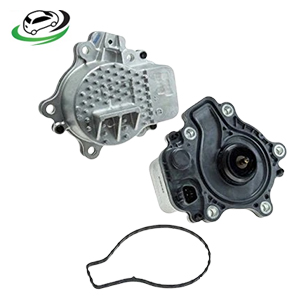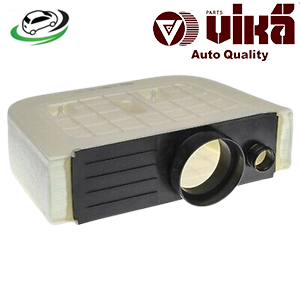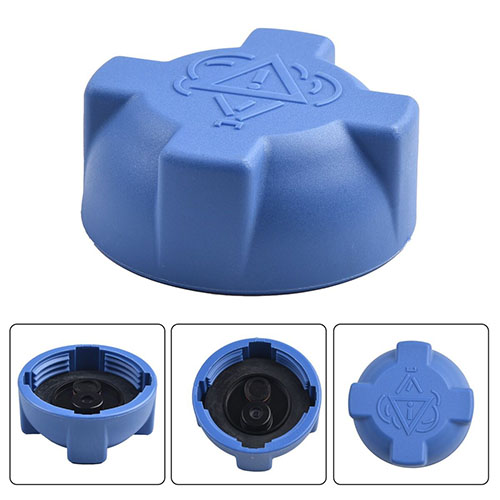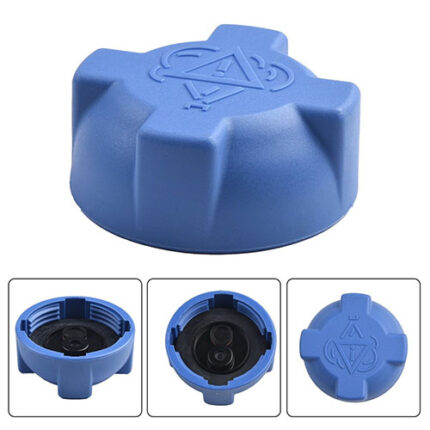-29%
Get VW Golf II Expansion Tank Cap 171121321 in Kenya
An expansion tank cap might seem like a small and insignificant component in a vehicle’s cooling system, but its role is crucial for the proper functioning and longevity of the engine. The expansion tank, sometimes referred to as the coolant reservoir, plays a vital role in maintaining the right pressure and temperature balance within the cooling system. The expansion tank cap, often overlooked, is a key player in this system. Below, we will delve into the function, design, maintenance, and importance of the expansion tank cap in a vehicle’s cooling system.
Design and Components of the Expansion Tank Cap
The expansion tank cap is designed with precision, combining materials and mechanisms that can withstand high temperatures, pressure, and exposure to various chemicals. The cap typically consists of the following components:
- Spring-loaded Pressure Valve: This valve is calibrated to open at a specific pressure, releasing excess pressure to the expansion tank. The spring’s tension is crucial in determining the cap’s pressure rating.
- Vacuum Relief Valve: This valve allows coolant or air to re-enter the cooling system as it cools and the pressure drops, preventing vacuum conditions.
- Gasket or Seal: The cap has a gasket or rubber seal that ensures a tight fit between the cap and the expansion tank. This seal is essential for maintaining the pressure within the system and preventing leaks.
- Locking Mechanism: The cap is designed with a locking mechanism that ensures it stays securely in place despite the vibrations and movements of the vehicle. Some caps have a two-step mechanism that requires the user to press down and turn to remove the cap, adding an extra layer of safety.
Benefits of Expansion Tank Cap
1. Pressure Regulation
- Maintains Optimal Pressure: The expansion tank cap ensures that the cooling system operates under the correct pressure. By maintaining the appropriate pressure, it prevents the coolant from boiling over, even at high temperatures. This is crucial for efficient heat dissipation and the prevention of overheating.
- Prevents Over-Pressurization: The cap’s pressure valve opens if the system pressure exceeds the designated limit, allowing excess coolant to flow into the expansion tank. This action prevents damage to the cooling system components, such as hoses and the radiator.
2. Prevents Engine Overheating
- Enhances Cooling Efficiency: By maintaining the coolant under pressure, the expansion tank cap raises the coolant’s boiling point. This allows the engine to operate at higher temperatures without the risk of the coolant boiling over, which is essential for efficient engine cooling.
- Prevents Boiling: The cap prevents the coolant from turning into steam within the engine, which could otherwise lead to overheating and significant engine damage, such as warped cylinder heads or a blown head gasket.
3. Protects Against Coolant Loss
- Seals the System: The expansion tank cap ensures a tight seal, preventing coolant from escaping the system. This helps maintain the correct coolant level and prevents the engine from running low on coolant, which could lead to overheating.
- Manages Coolant Overflow: The cap allows excess coolant to flow into the expansion tank when the system is under high pressure and then draws it back into the system as the engine cools. This helps in maintaining the right coolant volume within the system.
4. Prevents Vacuum Formation
- Vacuum Relief: The cap is equipped with a vacuum relief valve that allows air or coolant to re-enter the cooling system as it cools down. This prevents a vacuum from forming, which could cause the hoses to collapse and restrict coolant flow.
- Maintains System Integrity: By preventing vacuum formation, the cap ensures that the cooling system remains intact, preventing damage to hoses and maintaining consistent coolant flow through the engine.
5. Extends Engine Life
- Prevents Component Damage: By regulating pressure and preventing overheating, the expansion tank cap protects vital engine components, such as the radiator, water pump, and hoses, from damage. This prolongs the life of the cooling system and, by extension, the engine.
- Reduces Wear and Tear: Consistent pressure management reduces the strain on the cooling system, leading to less wear and tear on components. This results in fewer breakdowns and lower maintenance costs over the life of the vehicle.
6. Enhances Safety
- Prevents Overheating-Related Accidents: A properly functioning expansion tank cap helps prevent overheating, reducing the risk of engine fires or sudden breakdowns on the road, which could pose safety risks.
- Ensures Safe Coolant Handling: The cap’s design often includes safety features that prevent it from being opened while the system is under pressure, reducing the risk of scalding injuries from hot coolant.
7. Cost-Effective Maintenance
- Inexpensive Component: The expansion tank cap is a relatively inexpensive part to replace, especially when compared to the potential costs of repairing damage caused by overheating or coolant loss.
- Prevents Costly Repairs: By maintaining the correct pressure and preventing overheating, the cap helps avoid expensive repairs related to engine damage, such as fixing a blown head gasket or replacing a cracked engine block.
8. Supports Environmental Responsibility
- Prevents Coolant Leaks: A well-sealed expansion tank cap reduces the chances of coolant leaking into the environment, which is important as coolant is toxic and can be harmful to animals and plants.
- Reduces Coolant Consumption: By preventing coolant loss, the cap helps minimize the need for frequent coolant top-ups, reducing waste and supporting more sustainable vehicle operation.
9. Improves Vehicle Performance
- Maintains Optimal Engine Temperature: By keeping the engine within its ideal operating temperature range, the expansion tank cap ensures that the engine runs efficiently, leading to better performance and fuel economy.
- Stabilizes Engine Operation: The cap’s role in pressure regulation ensures consistent engine operation, preventing temperature fluctuations that could affect engine performance and fuel efficiency.
Signs of worn out Expansion Tank Cap
1. Coolant Leaks
- Visible Coolant Around the Cap: If you notice coolant seeping or leaking around the expansion tank cap, this is a strong indication that the cap is not sealing properly. A damaged or degraded gasket can cause coolant to escape, leading to a loss of pressure and coolant.
- Puddles Under the Vehicle: Leaking coolant might form puddles under your vehicle, especially after parking. These leaks often result from a cap that cannot maintain the correct pressure, causing coolant to overflow or escape.
2. Overheating Engine
- Frequent Overheating: An expansion tank cap that fails to maintain the proper pressure can cause the engine to overheat. Without the correct pressure, the coolant may boil, leading to overheating. If your engine temperature gauge frequently shows high temperatures, the cap might be to blame.
- Coolant Boiling in the Reservoir: If you observe the coolant boiling inside the expansion tank or see steam rising from it, this could indicate that the cap is not holding pressure, allowing the coolant to boil at a lower temperature than it should.
3. Low Coolant Levels
- Frequent Need for Coolant Top-Ups: If you find yourself having to regularly add coolant to the system, it could be due to the cap not sealing properly. Coolant loss may be slow and not immediately noticeable, but over time it will lead to a consistently low coolant level.
- Unexplained Coolant Loss: Even if there are no visible leaks, a faulty cap can allow coolant to escape as steam, leading to a gradual loss of coolant that might not be immediately apparent.
4. Collapsed Radiator Hoses
- Hoses Appear Collapsed or Crushed: If the vacuum relief valve within the expansion tank cap fails, it can cause a vacuum to form as the engine cools, leading to the collapse of radiator hoses. This can restrict coolant flow and cause further issues with engine cooling.
- Difficulty Starting the Vehicle: In severe cases, collapsed hoses can cause the engine to overheat rapidly after starting, making it difficult to drive the vehicle without immediate overheating.
5. Erratic Temperature Gauge Behavior
- Fluctuating Temperature Readings: A malfunctioning expansion tank cap can cause erratic readings on the temperature gauge, with the needle moving between normal and high temperatures unpredictably. This fluctuation often indicates that the cooling system is not maintaining stable pressure.
- Temperature Gauge Stays High: If the temperature gauge consistently reads high even after replacing coolant, it could indicate that the cap is not allowing the cooling system to function correctly.
6. Pressure Loss in the Cooling System
- Lack of Pressure When Opening the Cap: When the engine is hot, removing the expansion tank cap should release pressure with a noticeable hiss. If there’s no pressure release, it suggests that the cap has not been maintaining pressure, which can lead to overheating.
- Soft or Spongy Radiator Hoses: If the hoses feel soft or spongy rather than firm when the engine is hot, it could be a sign that the system is not holding pressure due to a faulty cap.
7. Steam or Strange Smells
- Steam from the Engine Bay: Seeing steam coming from under the hood, especially near the expansion tank, indicates that the coolant is likely boiling, which can be caused by a loss of pressure due to a faulty cap.
- Sweet Smell: A sweet, syrupy smell is often a sign of coolant leaking, either as a liquid or steam. This odor is a strong indicator that the cap may be compromised and not sealing correctly.
8. Check Engine Light
- Illuminated Warning Light: In modern vehicles, a malfunctioning cooling system can trigger a check engine light. This could be due to sensors detecting abnormal temperature or pressure levels, which might be caused by a failing expansion tank cap.
- Error Codes Related to Cooling System: Diagnostic tools may reveal error codes that indicate issues with the cooling system, often pointing to problems related to pressure regulation, which can be traced back to the expansion tank cap.
9. Cracks or Damage on the Cap
- Visible Cracks or Wear: Inspect the expansion tank cap for any visible cracks, chips, or signs of wear on the plastic or metal parts. Damage to the cap can prevent it from sealing properly and maintaining the necessary pressure.
- Worn-Out Gasket: The gasket or seal inside the cap should be intact and flexible. If it appears brittle, cracked, or flattened, it will not provide an adequate seal, leading to the issues mentioned above.
Follow us on Facebook for more parts.




